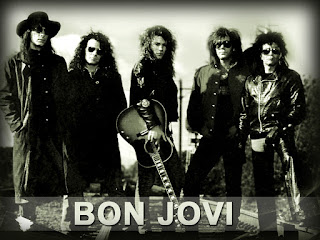Jon Bon Jovi (vocals), Ritchie Sambora (guitar),David Bryan (keyboards), Tico Torres (drums).
One of the most successful groups from the “hair metal” era of the 1980s, Bon Jovi’s particular blend of pop sensibility and working-class lyrical themes, along with a string of MTV videos showcasing Jon Bon Jovi’s good looks, gave them a wider appeal and longer career life than almost any of their direct peers, to the extent that they have continued to enjoy a viable career into the new millennium.
Jon Bongiovi (his real name) got his start through his cousin Tony Bongiovi, who owned the famous New York City recording studio The Power Station. After recording a series of demos at the studio, one of them, “Runaway,” became a local hit on New Jersey radio. Bongiovi subsequently put together a band featuring his longtime friend keyboardist David Rashbaum, drummer Tico Torres, bassist Alec John Such, and guitarist Dave Sabo. The band soon became the object of an
intense bidding war between a number of record labels. Ultimately, the band signed with Polygram in 1983. Before the release of the band’s debut, Bongiovi changed his name to Bon Jovi, Rashbaum changed his to Bryan (his middle name), and Richie Sambora replaced Dave Sabo (who would later go on to success with Skid Row).
Released in 1984, Bon Jovi was a success with “Runaway” replicating its previous success as a hit single on a national scale. Unfortunately, Tony Bongiovi sued the band, claiming that he had served to develop their successful sound. The suit was ultimately settled out of court. The band’s sophomore album, 7800 Fahrenheit, released in 1985, also did well. Seeking a higher level of success, the band
hired professional songwriter Desmond Child to collaborate on new material, which was subsequently test marketed to teens in the New York/New Jersey area. All of Bon Jovi’s R&D paid off with the 1986 album Slippery When Wet, which would go on to sell over nine million copies. Aided by a series of lush performance- oriented videos on MTV, the album made the band superstars. Featuring two number 1 hits in “You Give Love a Bad Name” and “Livin’ on a Prayer,” and the
top ten “Wanted Dead or Alive,” the album became the quintessential album of the pop-metal/hair band era.




